Physical Address
304 North Cardinal St.
Dorchester Center, MA 02124
This chapter is directed to pathologists who are confronted by certain viral infections of the central nervous system (CNS) that may have systemic involvement. The arboviral encephalitides and CNS infections caused by DNA viruses have been covered in other chapters. This chapter focuses on infections caused by RNA viruses in three different families: Rhabdoviridae, Arenaviridae (both enveloped viruses), and Picornaviridae (nonenveloped RNA viruses). An overview of the viral properties, epidemiology, clinical features, pathology, and pathogenesis of associated diseases will be provided.
Rabies is an acute, almost invariably fatal, encephalomyelitis caused by rabies virus (RABV); a single-stranded, negative-sense, enveloped RNA virus in the genus Lyssavirus, family Rhabdoviridae . Rabies is a zoonotic disease that causes more than 55,000 deaths worldwide on an annual basis. The dog is a major vector around the world, and dog bites account for the majority of cases in countries where dog rabies is endemic. In countries where dog rabies has been eradicated, including the United States and many industrialized nations, bites from wild animals account for the majority of cases. Within the United States, genotype 1 rabies virus variants circulate within specific, and often geographically distinct, populations including skunks, foxes, raccoons, and bats. These variants can “spill over” from the reservoir species into other wild and domestic animal populations and humans. In the interest of clarity, this section focuses on the clinical and pathologic features of classic rabies (RABV genotype 1 infection). The reader is directed to references following this section for a full discussion on the diverse phylogenetic, ecologic, and epidemiologic features and varying clinical manifestations of Lyssavirus infection.
Rabies virus is most frequently transmitted through a bite or scratch from a rabid animal. Transmission less frequently occurs through mucosal exposure to infected tissue (CNS) or fluids (saliva) and rarely by unconventional transmission routes (e.g., aerosolization, organ transplant).
RABV infections have distinct clinical stages that include an incubation period, prodromal period, acute neurologic stage, coma, and death. The incubation period is generally 1 to 3 months with a range of less than a week to years. The prodromal period generally lasts 2 to 10 days and is characterized by nonspecific symptoms (e.g., vomiting, diarrhea, fever, malaise, muscle pain, sore throat) that may include subtle personality or cognitive changes. In some cases, the prodromal period is marked by paresthesia, pain, or pruritus in the area or limb of inoculation, which can lead to regional skin excoriation ( Figure 8-1 ). The acute neurologic stage can be expressed or described as either encephalitic (furious) or paralytic (dumb), with each exhibiting a distinct clinical course. The encephalitic form accounts for approximately two thirds of patients and is characterized by hyperexcitability, agitation, and delirium. Patients can cycle between periods of unconsciousness offset with bouts of phobias (hydrophobia, aerophobia), inspiratory spasms, and signs of autonomic dysfunction (hypersalivation, priapism, spontaneous ejaculation, piloerection). Progression to coma and death or sudden death by cardiopulmonary arrest usually occurs within 7 days of onset. The paralytic form is more of a diagnostic challenge as early clinical signs are vague and cardinal signs, as observed in encephalitic rabies, are largely absent. Paralytic rabies is generally more protracted than the encephalitic form. Patients present with limb weakness and ascending paralysis that progresses to paraplegia and quadriplegia, frequently with bulbar involvement and progression to respiratory paralysis or cardiac dysrhythmia. Basic clinical laboratory studies are largely nondiagnostic, and cerebrospinal fluid (CSF) can be normal or demonstrate pleocytosis with moderately elevated protein.
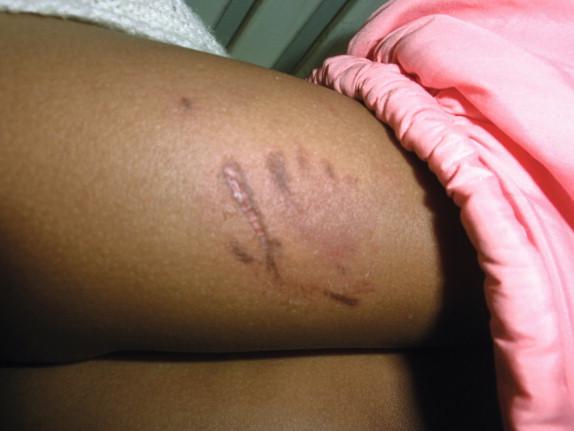
Antemortem diagnostics are based on serologic conversion, antigen identification, or molecular identification of viral RNA. Regardless of the specific test employed, currently, no assay can detect infection with rabies virus before the onset of clinical disease. In unvaccinated individuals, serologic assays on serum and CSF are often positive only in the later stages of disease. The traditional standard test for antigen detection is a direct fluorescent antibody (DFA) test on brain tissue collected postmortem. The DFA test can also be used for antemortem diagnostic testing, although brain biopsy is often impractical. Antigen identification in non-CNS specimens is possible with a direct rapid fluorescent antibody test, or an immunohistochemical test performed on fresh tissues can be highly sensitive. Antigen detection using indirect fluorescent antibody (IFA) or immunohistochemistry (IHC) testing of frozen skin samples from the head, often from the nape of the neck, demonstrates antigen within nerve fibers surrounding hair follicles.
Magnetic resonance (MR) imaging findings can vary in rabies and are nonspecific. Prior to the comatose phase, MR imaging shows increased T2-weighted signal without contrast enhancement in the white matter, limbic system, thalamus, brainstem, and spinal cord ( Figure 8-2 ). Widespread increase of T2-weighted signal is observed as disease progresses to the comatose phase.
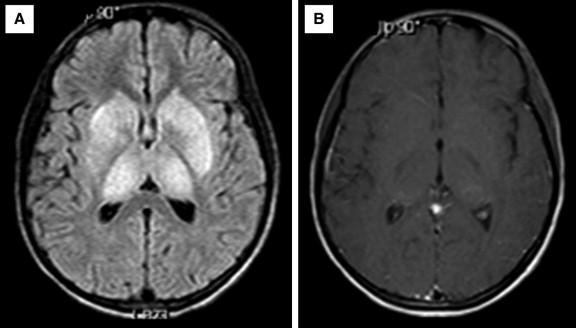
The brain shows few alterations other than vascular congestion in patients who are not provided respiratory support. In cases that are supported with ventilation, severe congestion and edema can be observed.
The distribution, character, and degree of inflammation in the CNS are highly variable. The distribution can include any neuroanatomic region of the brain or spinal cord, however; the brainstem and spinal cord often show the most significant inflammatory infiltrates. In paralytic rabies, the inflammation predominates in the spinal cord and ganglia, with the lumbar and lower dorsal segments showing the most severe inflammation. Inflammation is often perivascular but can involve large portions of the neuropil and meninges. The inflammatory infiltrates are most frequently lymphocytes, plasma cells, and macrophages. Cases occasionally have conspicuous neutrophils, which has been loosely correlated with early disease. Glial nodules (Babes nodules) are observed in some cases, as is microglial proliferation that is often pronounced in the medulla oblongata. Some cases demonstrate abundant elongated microglial cells ( Figure 8-3 ). Microglia aggregating around neuronal cell bodies may be observed. Neuronal degeneration is highly variable between cases and ranges from an infrequent to prominent finding, which is likely more a function of hypoxia than direct viral injury. Peripheral nerves can show Wallerian degeneration and segmental demyelination and foci of inflammation composed of predominantly lymphocytes ( Figure 8-4 ).
Rabies virus (RABV) is a single-stranded, negative-sense, enveloped RNA virus in the genus Lyssavirus, family Rhabdoviridae .
Rabies virus has a worldwide distribution with the exception of a few island nations and Antarctica.
The World Health Organization (WHO) estimates greater than 55,000 deaths occur annually worldwide.
Worldwide, children under 15 are disproportionately affected.
No recognized race or gender distribution.
Rabies has distinct clinical stages that include an incubation period, prodromal period, acute neurologic stage, coma, and death.
Prodromal period generally lasts 2 to 10 days and is characterized by nonspecific symptoms.
Acute neurologic stage can be expressed or described as either encephalitic (furious) or paralytic (dumb). Encephalitic and paralytic rabies have distinct clinical presentations and courses with congruent outcomes.
Patients with encephalitic rabies show hyperexcitability, phobias (aero-, hydro-), and signs of autonomic dysfunction.
Patients with paralytic rabies show limb weakness that progresses to ascending paralysis.
Mortality approaches 100%.
Magnetic resonance images show increased weighted T2 signal in the white matter, limbic system, thalamus, brainstem, and spinal cord.
Prognosis is grave after onset of symptoms, and therapy is supportive in nature.
Therapy should focus on postexposure prophylaxis.
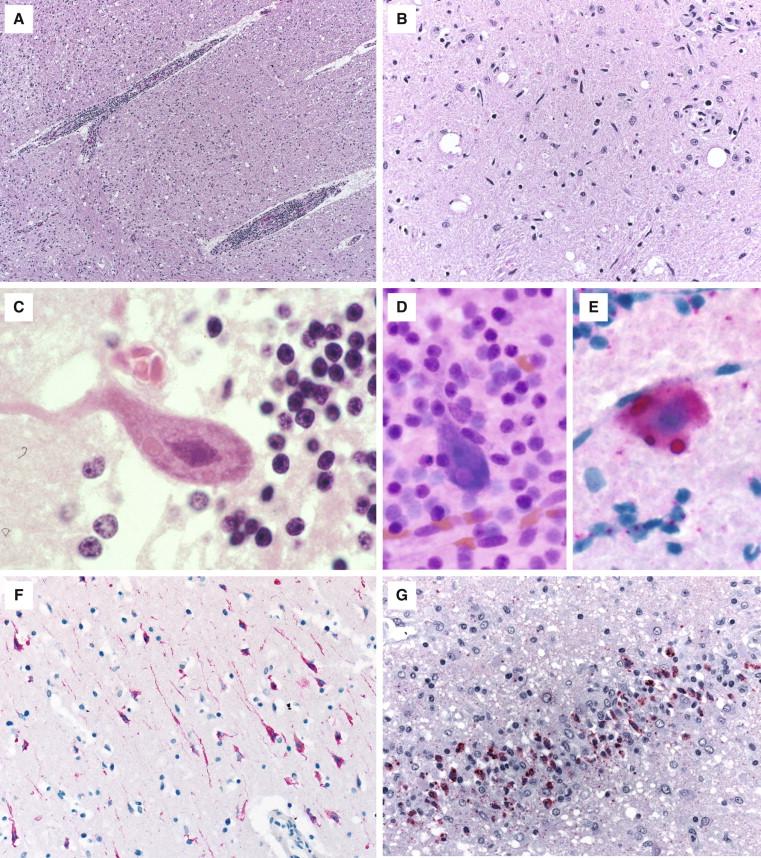
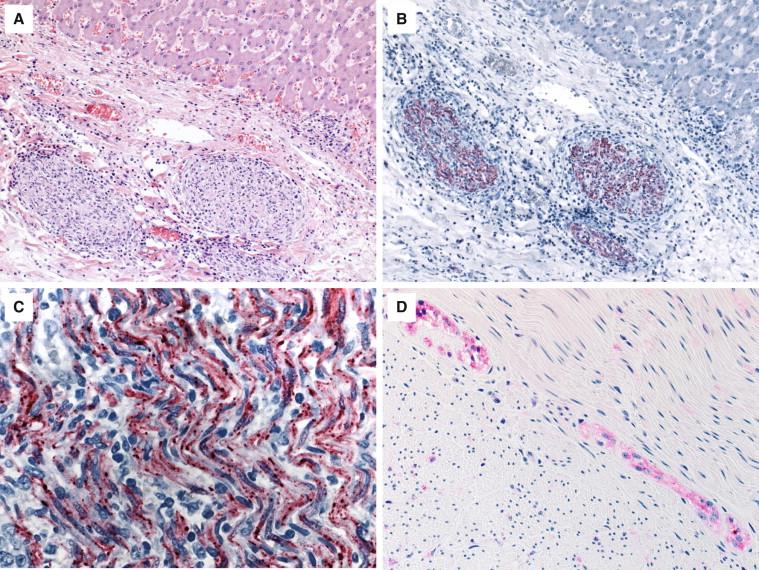
Negri bodies, the diagnostic hallmark of rabies virus infection, are intracytoplasmic, eosinophilic inclusion bodies with fine basophilic stippling that are often surrounded by a clear halo. Negri bodies are present in approximately 70% of cases and are most frequently observed in large neurons within the brainstem, Purkinje cells, or neurons in Ammon’s horn, although they can be observed within any neuron ( Figure 8-3C-E ).
Notable areas of non-neural tissues with significant histopathology include the heart ( Figure 8-5A ), with foci of mononuclear inflammation throughout the interstitium, and salivary glands, with foci of mononuclear inflammation within periacinar connective tissues.

RABV antigen can be detected by IHC in a variety of cell types. Given the neurotrophic nature of RABV, the cytoplasm of neurons, non-neuronal CNS cells, ganglia, and peripheral nerves are notable sites of antigen accumulation. Antigen can be observed in other non-neural cell types including cardiomyocytes, salivary gland acinar epithelial cells ( Figure 8-5B-F ), and basal cells of multiple epithelial surfaces and external root sheath cells of hair follicles.
The brain shows minimal change, with vascular congestion being the most frequent finding.
Highly variable neuroanatomic distribution and severity of predominantly perivascular mononuclear cell inflammation in the CNS.
Seventy percent of cases have characteristic intracytoplasmic inclusion bodies (Negri bodies).
Immunohistochemical staining demonstrates cytoplasmic staining of multiple cell types.
Negative stain transmission electron microscopic examination can show bullet-shaped virions that are 75 × 180 nm.
Thin section transmission electron microscopy shows aggregates of electron dense material that are variably accompanied by viral particles that are observed throughout the matrix or clustered at the edge, which together correspond with Negri bodies observed at the light level.
Reverse transcription polymerase chain reaction (RT-PCR) on saliva, tears, CSF, urine, and other tissues is highly sensitive when sequential testing is performed, as intermittent shedding is the norm. Negative stain transmission electron microscopic examination can show bullet-shaped virions that are 75 × 180 nm ( Figure 8-6A ). Thin section transmission electron microscopy shows aggregates of electron-dense, amorphous material that are variably accompanied by spherical or tubular viral particles ( Figure 8-6B ). The virions are observed throughout the matrix or clustered at the edge, which together correspond with Negri bodies observed at the light level.
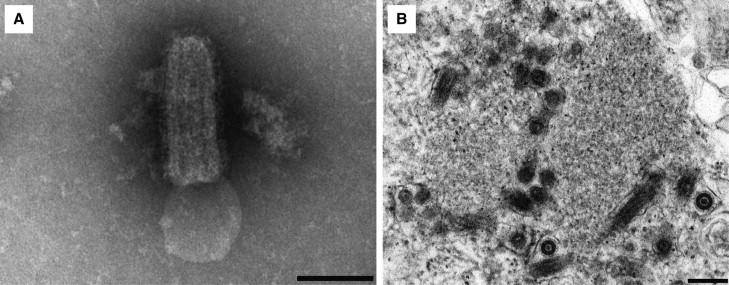
The histopathologic appearance of rabies encephalitis closely resembles other viral encephalitides with the notable exception of the presence of Negri bodies. Two important diseases that also have cytoplasmic eosinophilic inclusions that may resemble Negri bodies are measles and Nipah virus infection ( Figure 8-7 ). These can be differentiated by clinical and epidemiologic features and laboratory tests including IHC and PCR. The paralytic form of rabies shares features with Guillain-Barré syndrome but is clinically distinct because of the presence of myoedema, progression to coma, and urinary incontinence.
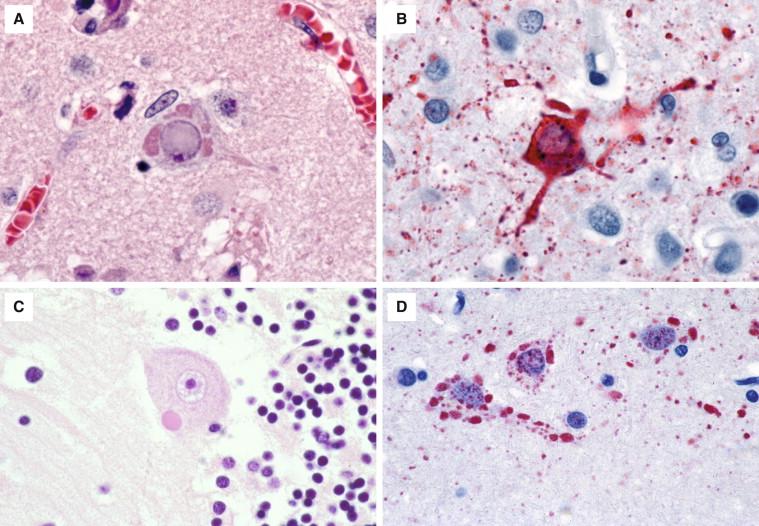
Prognosis is poor after the onset of clinical disease, with mortality approaching 100%. Reports of recovery from clinical disease are rare, and therapy is supportive in nature. A protocol to induce coma and support vital systems has been described but has shown limited success. Given the high mortality, therapy should focus on postexposure prophylaxis (PEP) before disease onset. PEP would include a series of vaccinations with human diploid cell vaccine (HDCV) or purified chick embryo cell vaccine (PCECV) administered intramuscularly and rabies immunoglobulin (RIG) locally infiltrated on the first day of PEP at the site of injury, if anatomically possible, or intramuscularly at a site remote to vaccination. The regimen varies for previously vaccinated, unvaccinated immunocompetent, and unvaccinated immunocompromised individuals. Preexposure vaccination is recommended for at-risk populations including laboratorians that work with rabies virus, those with extensive domestic or wild animal exposure (veterinarians, wildlife biologists, etc.), and those traveling to countries with dog rabies, particularly if visiting remote areas with large numbers of dogs or for extended (greater than 1 month) travel.
Become a Clinical Tree membership for Full access and enjoy Unlimited articles
If you are a member. Log in here